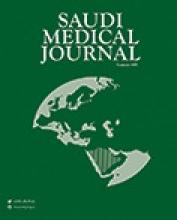Abstract
OBJECTIVE: To assess cardiac dimensions in elite Saudi soccer players, and to correlate these measurements with maximal oxygen uptake.
METHODS: Twenty-three soccer players representing the Saudi National soccer team, and 19 untrained males participated in this study. Cardiac dimensions were measured by M-mode echocardiography, and maximal oxygen uptake was assessed by open-circuit spirometry during treadmill running.
RESULTS: When compared with age-matched untrained males, soccer players appeared to have significantly (P<0.05) greater values (mm.m-2) in left ventricular end-diastolic dimension (28.8 ± 2.7 vs 26.5 ± 2.3), right ventricular cavity (14.1 ± 2.5 vs 11.8 ± 2.6), left atrial cavity (16.7 ± 1.6 vs 14.9 ± 2.2) and left ventricular mass (117.4 ± 21.2 vs 89.0 ± 16.0 g.m-2). There was no significant difference between the 2 groups in left ventricular posterior wall (5.3 ± 0.77 vs 5.3 ± 0.61) or in interventricular septum (5.5 ± 0.65 vs 5.2 ± 0.59). When soccer players were grouped by playing position, there were no significant differences in cardiac dimensions between the players, though the midfielders and the full-backs showed the highest values for left ventricular cavity and maximal oxygen uptake. Further, maximal oxygen uptake relative to body mass (ml.kg.-1 min-1) exhibited a significant correlation with left ventricular cavity normalized to either body mass (r = 0.62; P <0.01), or to body surface area (r = 0.53; P < 0.05).
CONCLUSION: The elite Saudi soccer players appear to have significantly greater left ventricular cavity and mass than age-matched untrained males. Such cardiac adaptation seems to result from the highly dynamic nature of the soccer game.
- Copyright: © Saudi Medical Journal
This is an open-access article distributed under the terms of the Creative Commons Attribution-Noncommercial-Share Alike 3.0 Unported, which permits unrestricted use, distribution, and reproduction in any medium, provided the original work is properly cited.






